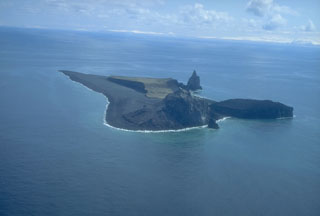Report on Bogoslof (United States) — 15 February-21 February 2017
Smithsonian Institution / US Geological Survey
Weekly Volcanic Activity Report, 15 February-21 February 2017
Managing Editor: Sally Sennert.
Please cite this report as:
Global Volcanism Program, 2017. Report on Bogoslof (United States) (Sennert, S, ed.). Weekly Volcanic Activity Report, 15 February-21 February 2017. Smithsonian Institution and US Geological Survey.
Bogoslof
United States
53.93°N, 168.03°W; summit elev. 150 m
All times are local (unless otherwise noted)
AVO reported that during 15-16 February cloud cover prevented satellite views of Bogoslof; no other data indicated eruptive activity. At 0955 on 17 February seismic data indicated the beginning of an explosive event, prompting AVO to raise the Aviation Color Code (ACC) to Red and the Volcano Alert Level (VAL) to Warning. Individual pulses of seismicity was recorded until 1140, and then afterwards seismicity was low. Satellite images and pilot observations indicated that an ash plume rose to an altitude of 11.6 km (38,000 ft) a.s.l. The event was also verified by infrasound and lightning data. Another short-lived explosive event began at 1546, detected in infrasound and seismic data. A volcanic cloud identified in satellite images rose as high as 7.6 km (25,000 ft) a.s.l.
An explosion at 0450 on 18 February was detected in seismic, infrasound, and lightning data. The seismic data suggested that ash emissions lasted several minutes, and then seismicity decreased. A preliminary evaluation of satellite data indicated that a cloud rose at least as high as 7.6 km (25,000 ft) a.s.l.; the cloud drifted SW. On 19 February the ACC was lowered to Orange and the VAL was lowered to Watch. Later that day seismic and infrasound data recorded a series of short-lived explosive pulses during 1708-1745. The ACC was raised to Red and the VAL was raised to Warning. A plume identified in satellite images rose as high as 7.6 km (25,000 ft) a.s.l. and drifted 160 km SE over Unalaska Island. AVO geologists on the island described the cloud has having a white upper portion and a slightly darker lower portion. Storms in the region impacted data communications at AVO's facility in Dutch Harbor on 20 February, limiting AVO's ability to forecast and detect eruptions at Bogoslof.
Geological Summary. Bogoslof is the emergent summit of a submarine volcano that lies 40 km N of the main Aleutian arc. It rises 1,500 m above the Bering Sea floor. Repeated construction and destruction of lava domes at different locations during historical time has greatly modified the appearance of this "Jack-in-the-Box" volcano and has introduced a confusing nomenclature applied during frequent visits by exploring expeditions. The present triangular-shaped, 0.75 x 2 km island consists of remnants of lava domes emplaced from 1796 to 1992. Castle Rock (Old Bogoslof) is a steep-sided pinnacle that is a remnant of a spine from the 1796 eruption. The small Fire Island (New Bogoslof), about 600 m NW of Bogoslof Island, is a remnant of a lava dome formed in 1883.
Source: US Geological Survey Alaska Volcano Observatory (AVO)

